Unit 8 It must belong to Carla. SectionA Grammar Focus-4c 课件(18张PPT)2021-2022学年人教版英语九年级全册
文档属性
| 名称 | Unit 8 It must belong to Carla. SectionA Grammar Focus-4c 课件(18张PPT)2021-2022学年人教版英语九年级全册 | 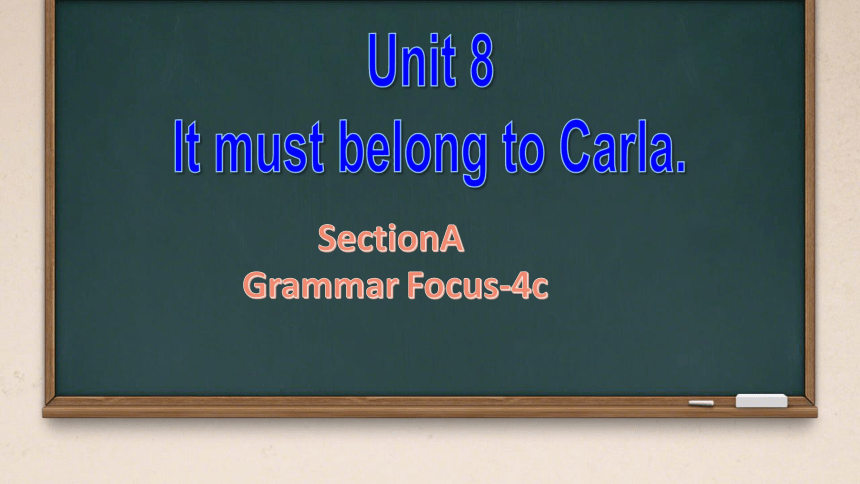 | |
| 格式 | pptx | ||
| 文件大小 | 3.0MB | ||
| 资源类型 | 教案 | ||
| 版本资源 | 人教新目标(Go for it)版 | ||
| 科目 | 英语 | ||
| 更新时间 | 2023-09-22 14:39:10 | ||
图片预览

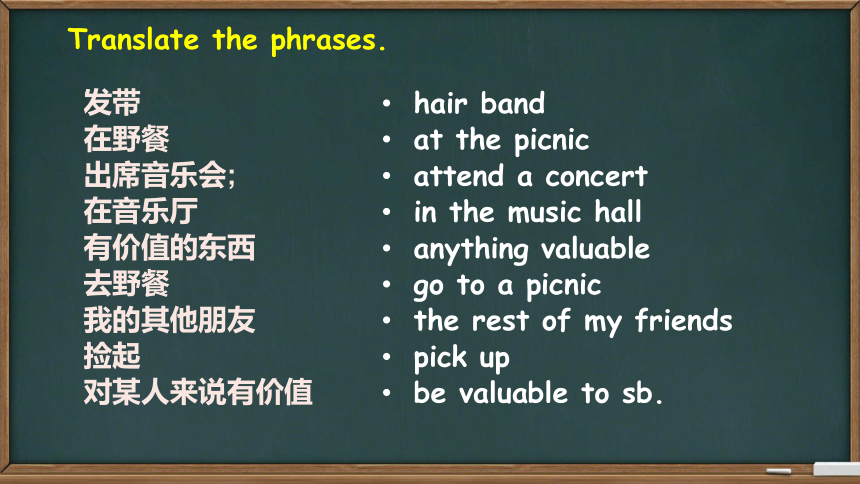

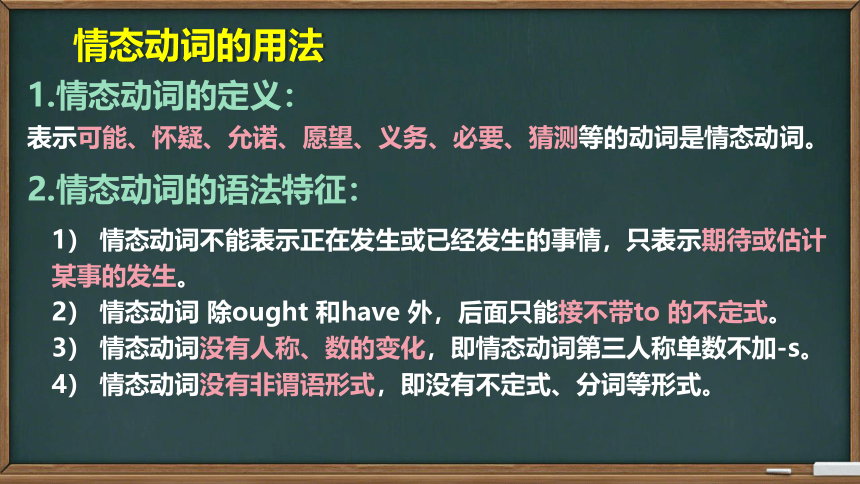
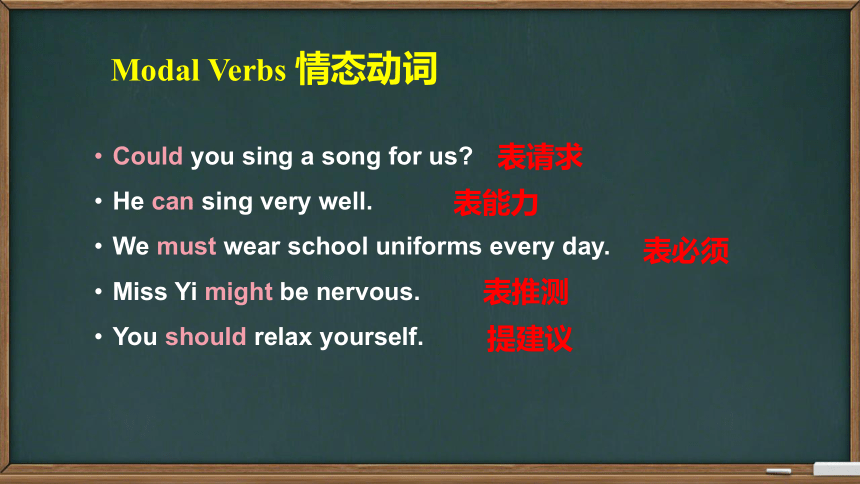
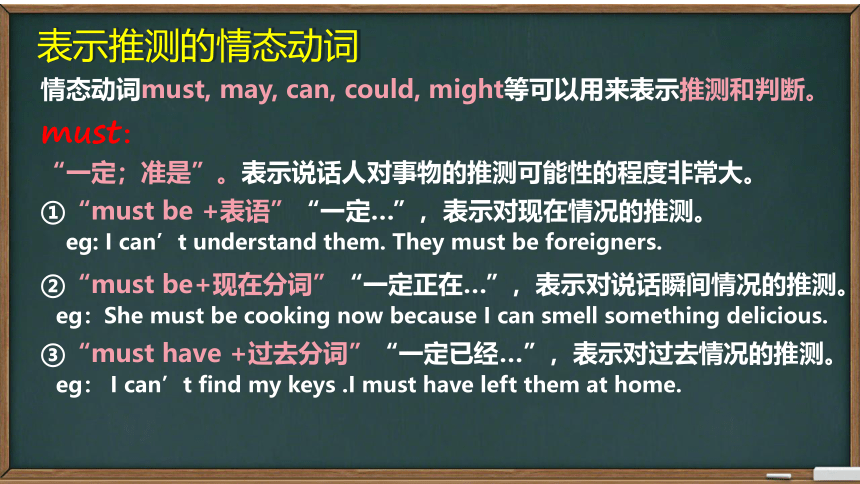
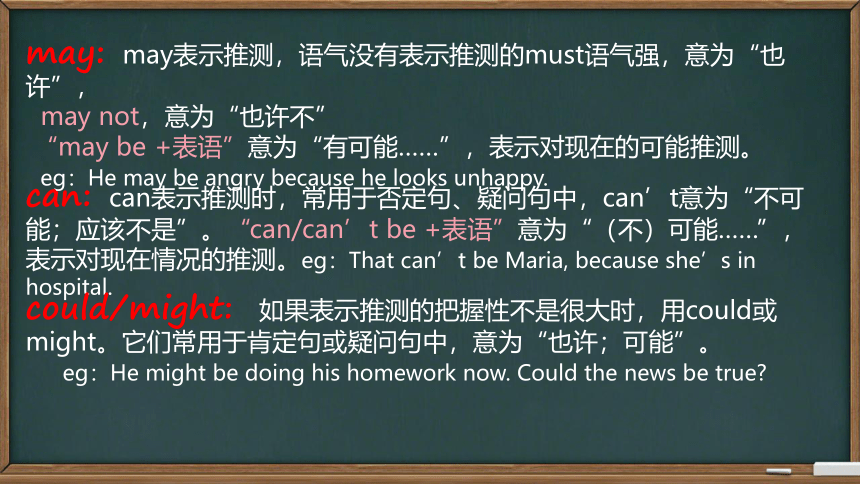
文档简介
(共18张PPT)
Unit 8
It must belong to Carla.
SectionA
Grammar Focus-4c
发带
在野餐
出席音乐会;
在音乐厅
有价值的东西
去野餐
我的其他朋友
捡起
对某人来说有价值
hair band
at the picnic
attend a concert
in the music hall
anything valuable
go to a picnic
the rest of my friends
pick up
be valuable to sb.
Translate the phrases.
Grammar Focus
情态动词表示推测
情态动词的用法
1.情态动词的定义:
表示可能、怀疑、允诺、愿望、义务、必要、猜测等的动词是情态动词。
1) 情态动词不能表示正在发生或已经发生的事情,只表示期待或估计某事的发生。
2) 情态动词 除ought 和have 外,后面只能接不带to 的不定式。
3) 情态动词没有人称、数的变化,即情态动词第三人称单数不加-s。
4) 情态动词没有非谓语形式,即没有不定式、分词等形式。
2.情态动词的语法特征:
Modal Verbs 情态动词
Could you sing a song for us
He can sing very well.
We must wear school uniforms every day.
Miss Yi might be nervous.
You should relax yourself.
表请求
表能力
表必须
表推测
提建议
表示推测的情态动词
情态动词must, may, can, could, might等可以用来表示推测和判断。
must:
“一定;准是”。表示说话人对事物的推测可能性的程度非常大。
①“must be +表语”“一定…”,表示对现在情况的推测。
eg: I can’t understand them. They must be foreigners.
②“must be+现在分词”“一定正在…”,表示对说话瞬间情况的推测。
eg:She must be cooking now because I can smell something delicious.
③“must have +过去分词”“一定已经…”,表示对过去情况的推测。
eg: I can’t find my keys .I must have left them at home.
may: may表示推测,语气没有表示推测的must语气强,意为“也许”,
may not,意为“也许不”
“may be +表语”意为“有可能……”,表示对现在的可能推测。
eg:He may be angry because he looks unhappy.
can: can表示推测时,常用于否定句、疑问句中,can’t意为“不可能;应该不是”。“can/can’t be +表语”意为“(不)可能……”,表示对现在情况的推测。eg:That can’t be Maria, because she’s in hospital.
could/might: 如果表示推测的把握性不是很大时,用could或might。它们常用于肯定句或疑问句中,意为“也许;可能”。
eg:He might be doing his homework now. Could the news be true
注 意:
(3)can 表示推测通常不用于肯定句
may 表示推测通常不用于疑问句
must 表示推测通常不用于否定句和疑问句
can不肯,
may不问,
must 不否问
(1)情态动词表示推测时,无时态区别,只有语气差别。表示推测的情态动词的语气强弱顺序如下
(由强到弱):must > can > could > may > might
(2)含有must的句子(must表推测)变为否定句时,要用can’t
He must be at home. →He can’t be at home.
在反意疑问句中,当谓语动词含有must/might/can表推测意义时,疑问部分的助动词应与情态动词后面的动词在非推测情况下的用法一致。
The truck must be his, ______ he
Grace must have read the book last night, ______ she?
isn't
didn't
Summary
情态动词后面必须用动词原型。
情态动词做句型变化时只需对情态动词做相应的变化。
情态动词可以表示能力、请求、允许、猜测、建议、必须、需要等涵义,并且都有各自的用法。
学会使用思维导图来使得知识条理会,系统化,最重要的是你的思维要条理化。
4a
Choose the best way to complete each sentence using the words in the brackets.
1. A: Where’s Jean
B: I’m not sure. She _________ (is / might be / must be) in the laboratory.
2. A: Everyone is going to the pool after school.
B: Really It _________ (must be / can’t be / could be) hot outdoors.
3. A: That’s the phone.
B: Hmm. I wonder who it ________ (must be / could be / should be).
4. A: I wonder if these are Jim’s glasses.
B: They _____ (can’t be / might be / could be) his. He doesn’t wear glasses.
5. A: I hear water running in the bathroom.
B: It _________ (could be / must be / can’t be) Carla. She was thinking of
taking a shower.
might be
must be
could be
can’t be
must be
Complete these responses.
4b
1. A: Many people are wearing coats.
B: The weather must be_________________________.
2. A: Sally has been coughing a lot.
B: She might be ____________________.
getting colder/ cold outside
having a sore throat/ill
n. 外套
must be delicious
be that boring
adj. 困的
3. A: This restaurant is always very crowded.
B: The food ________________.
4. A: Whenever I try to read this book, I feel sleepy.
B: It can’t ______________.
sleep, sleepy & asleep
sleep, sleepy和asleep这三个词都与“睡觉”有关,但它们的含义和用法有区别。
单词 词性 含义 用法 例句
sleep 名词 睡眠 不可数名词 Just lie down and get enough sleep.
一次睡眠;一段睡眠时间 前可加a I’ll go upstairs and have a sleep.
动词 睡觉;睡 不及物动词 Did you sleep well last night
单词 词性 含义 用法 例句
sleepy 形容词 困倦的;瞌睡的 既能作定语,也能作表语 Do you know the sleepy girl
I’m too sleepy to finish my report.
asleep 形容词 睡着的 通常作表语;常和be或fall搭配使用 If I am asleep on the bus, please wake me up when you get off the bus.
Look at this picture of a room. How much can you tell about the person who lives here Is it a boy or a girl What are his / her hobbies Discuss your ideas with a partner.
4c
Sample Dialogue
A: It could be a girl’s room because it’s very tidy.
B: I guess so . But it might be a boy’s room because the clothes look like boys’ clothes.
还可以猜:age,job...
1. 表示推测的情态动词:
在英语中,表示对某件事物的确定程度,即表示推测的时候,我们通常会用到以下情态动词 must, can, could, might。
★情态动词 must, can, could, might 后接动词原形,表示对现在情况的推测。
2. 用法:
①“情态动词 + 动词原形”表示对现在或将来的情况进行推测。
②“情态动词 + be + v-ing形式”表示对正在进行的情况进行推测。
③“情态动词 + have + v-ed”表示对过去的情况进行推测。
Summary
1. Review Grammar.
2. Finish Activity 4c.
3. Preview Section B 1a-1d.
Unit 8
It must belong to Carla.
SectionA
Grammar Focus-4c
发带
在野餐
出席音乐会;
在音乐厅
有价值的东西
去野餐
我的其他朋友
捡起
对某人来说有价值
hair band
at the picnic
attend a concert
in the music hall
anything valuable
go to a picnic
the rest of my friends
pick up
be valuable to sb.
Translate the phrases.
Grammar Focus
情态动词表示推测
情态动词的用法
1.情态动词的定义:
表示可能、怀疑、允诺、愿望、义务、必要、猜测等的动词是情态动词。
1) 情态动词不能表示正在发生或已经发生的事情,只表示期待或估计某事的发生。
2) 情态动词 除ought 和have 外,后面只能接不带to 的不定式。
3) 情态动词没有人称、数的变化,即情态动词第三人称单数不加-s。
4) 情态动词没有非谓语形式,即没有不定式、分词等形式。
2.情态动词的语法特征:
Modal Verbs 情态动词
Could you sing a song for us
He can sing very well.
We must wear school uniforms every day.
Miss Yi might be nervous.
You should relax yourself.
表请求
表能力
表必须
表推测
提建议
表示推测的情态动词
情态动词must, may, can, could, might等可以用来表示推测和判断。
must:
“一定;准是”。表示说话人对事物的推测可能性的程度非常大。
①“must be +表语”“一定…”,表示对现在情况的推测。
eg: I can’t understand them. They must be foreigners.
②“must be+现在分词”“一定正在…”,表示对说话瞬间情况的推测。
eg:She must be cooking now because I can smell something delicious.
③“must have +过去分词”“一定已经…”,表示对过去情况的推测。
eg: I can’t find my keys .I must have left them at home.
may: may表示推测,语气没有表示推测的must语气强,意为“也许”,
may not,意为“也许不”
“may be +表语”意为“有可能……”,表示对现在的可能推测。
eg:He may be angry because he looks unhappy.
can: can表示推测时,常用于否定句、疑问句中,can’t意为“不可能;应该不是”。“can/can’t be +表语”意为“(不)可能……”,表示对现在情况的推测。eg:That can’t be Maria, because she’s in hospital.
could/might: 如果表示推测的把握性不是很大时,用could或might。它们常用于肯定句或疑问句中,意为“也许;可能”。
eg:He might be doing his homework now. Could the news be true
注 意:
(3)can 表示推测通常不用于肯定句
may 表示推测通常不用于疑问句
must 表示推测通常不用于否定句和疑问句
can不肯,
may不问,
must 不否问
(1)情态动词表示推测时,无时态区别,只有语气差别。表示推测的情态动词的语气强弱顺序如下
(由强到弱):must > can > could > may > might
(2)含有must的句子(must表推测)变为否定句时,要用can’t
He must be at home. →He can’t be at home.
在反意疑问句中,当谓语动词含有must/might/can表推测意义时,疑问部分的助动词应与情态动词后面的动词在非推测情况下的用法一致。
The truck must be his, ______ he
Grace must have read the book last night, ______ she?
isn't
didn't
Summary
情态动词后面必须用动词原型。
情态动词做句型变化时只需对情态动词做相应的变化。
情态动词可以表示能力、请求、允许、猜测、建议、必须、需要等涵义,并且都有各自的用法。
学会使用思维导图来使得知识条理会,系统化,最重要的是你的思维要条理化。
4a
Choose the best way to complete each sentence using the words in the brackets.
1. A: Where’s Jean
B: I’m not sure. She _________ (is / might be / must be) in the laboratory.
2. A: Everyone is going to the pool after school.
B: Really It _________ (must be / can’t be / could be) hot outdoors.
3. A: That’s the phone.
B: Hmm. I wonder who it ________ (must be / could be / should be).
4. A: I wonder if these are Jim’s glasses.
B: They _____ (can’t be / might be / could be) his. He doesn’t wear glasses.
5. A: I hear water running in the bathroom.
B: It _________ (could be / must be / can’t be) Carla. She was thinking of
taking a shower.
might be
must be
could be
can’t be
must be
Complete these responses.
4b
1. A: Many people are wearing coats.
B: The weather must be_________________________.
2. A: Sally has been coughing a lot.
B: She might be ____________________.
getting colder/ cold outside
having a sore throat/ill
n. 外套
must be delicious
be that boring
adj. 困的
3. A: This restaurant is always very crowded.
B: The food ________________.
4. A: Whenever I try to read this book, I feel sleepy.
B: It can’t ______________.
sleep, sleepy & asleep
sleep, sleepy和asleep这三个词都与“睡觉”有关,但它们的含义和用法有区别。
单词 词性 含义 用法 例句
sleep 名词 睡眠 不可数名词 Just lie down and get enough sleep.
一次睡眠;一段睡眠时间 前可加a I’ll go upstairs and have a sleep.
动词 睡觉;睡 不及物动词 Did you sleep well last night
单词 词性 含义 用法 例句
sleepy 形容词 困倦的;瞌睡的 既能作定语,也能作表语 Do you know the sleepy girl
I’m too sleepy to finish my report.
asleep 形容词 睡着的 通常作表语;常和be或fall搭配使用 If I am asleep on the bus, please wake me up when you get off the bus.
Look at this picture of a room. How much can you tell about the person who lives here Is it a boy or a girl What are his / her hobbies Discuss your ideas with a partner.
4c
Sample Dialogue
A: It could be a girl’s room because it’s very tidy.
B: I guess so . But it might be a boy’s room because the clothes look like boys’ clothes.
还可以猜:age,job...
1. 表示推测的情态动词:
在英语中,表示对某件事物的确定程度,即表示推测的时候,我们通常会用到以下情态动词 must, can, could, might。
★情态动词 must, can, could, might 后接动词原形,表示对现在情况的推测。
2. 用法:
①“情态动词 + 动词原形”表示对现在或将来的情况进行推测。
②“情态动词 + be + v-ing形式”表示对正在进行的情况进行推测。
③“情态动词 + have + v-ed”表示对过去的情况进行推测。
Summary
1. Review Grammar.
2. Finish Activity 4c.
3. Preview Section B 1a-1d.
同课章节目录
- Unit 1 How can we become good learners.
- Section A
- Section B
- Unit 2 I think that mooncakes are delicious!
- Section A
- Section B
- Unit 3 Could you please tell me where the restroom
- Section A
- Section B
- Unit 4 I used to be afraid of the dark.
- Section A
- Section B
- Unit 5 What are the shirts made of?
- Section A
- Section B
- Review of Units 1-5
- Unit 6 When was it invented?
- Section A
- Section B
- Unit 7 Teenagers should be allowed to choose their
- Section A
- Section B
- Unit 8 It must belong to Carla.
- Section A
- Section B
- Unit 9 I like music that I can dance to.
- Section A
- Section B
- Unit 10 You're supposed to shake hands.
- Section A
- Section B
- Review of Units 6-10
- Unit 11 Sad movies make me cry.
- Section A
- Section B
- Unit 12 Life is full of the unexpected
- Section A
- Section B
- Unit 13 We're trying to save the earth!
- Section A
- Section B
- Unit 14 I remember meeting all of you in Grade 7.
- Section A
- Section B
- Review of Units 11-14
